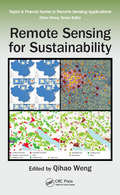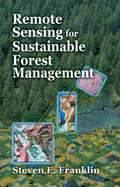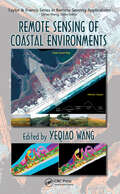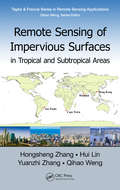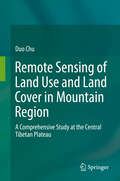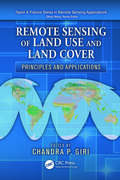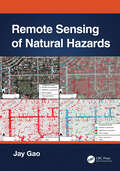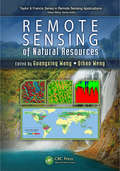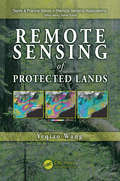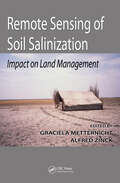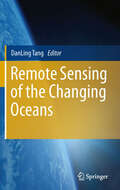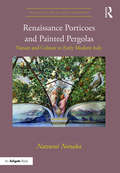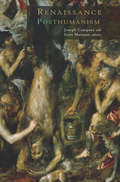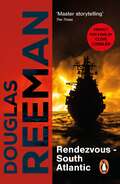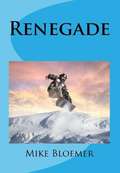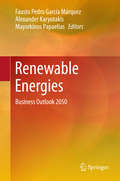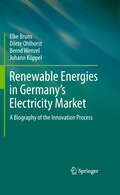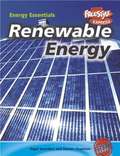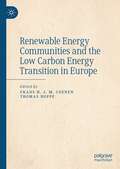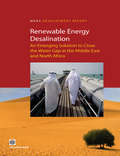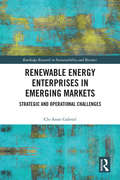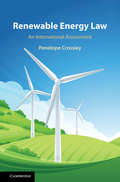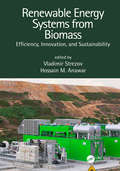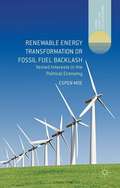- Table View
- List View
Remote Sensing for Sustainability (Remote Sensing Applications Series)
by Qihao WengDriven by the societal needs and improvement in sensor technology and image processing techniques, remote sensing has become an essential geospatial tool for understanding the Earth and managing Human-Earth interactions. Remote Sensing for Sustainability introduces the current state of the art remote sensing knowledge integral for monitoring the world’s natural resources and environments, managing exposure to natural disasters and man-made risks, and helping understand the sustainability and productivity of natural ecosystems. Bridging the gap between remote sensing and sustainability science this book examines theories and methods as well as practical applications of sustainable development for cities using remote sensing; focuses on remote sensing methods and techniques for sustainable natural resources with emphasize on forests; answers questions on how and what the remote sensing methods and techniques can do for the sustainability of environmental systems; and examines the issues of energy use and sustainable energy sources using remote sensing technology in countries such as Germany, China, the U.S, drawing on case studies to demonstrate the applicability of remote sensing techniques. This comprehensive guide, which can serve to professors, researchers, and students alike, takes in consideration the United Nations set of sustainable development goals and intends to contribute to the GEO’s Strategic Plan by addressing and exemplifying a number of societal benefit areas of remote sensing data sets, methods, and techniques for sustainable development.
Remote Sensing for Sustainable Forest Management
by Steven E. FranklinAs remote sensing data and methods have become increasingly complex and varied - and increasingly reliable - so have their uses in forest management. New algorithms have been developed in virtually every aspect of image analysis, from classification to enhancements to estimating parameters. Remote Sensing for Sustainable Forest Management reviews t
Remote Sensing of Coastal Environments (Remote Sensing Applications Series)
by Yeqiao WangAs coastal environments around the world face unprecedented natural and anthropogenic threats, advancements in the technologies that support geospatial data acquisition, imaging, and computing have profoundly enhanced monitoring capabilities in coastal studies. Providing systematic treatment of the key developments, Remote Sensing of Coastal Enviro
Remote Sensing of Impervious Surfaces in Tropical and Subtropical Areas (Remote Sensing Applications Series)
by Qihao Weng Hongsheng Zhang Hui Lin Yuanzhi ZhangRemote Sensing of Impervious Surfaces in Tropical and Subtropical Areas offers a complete and thorough system for using optical and synthetic aperture radar (SAR) remote sensing data for improving impervious surface estimation (ISE). Highlighting tropical and subtropical areas where there is significant cloud occurrence and varying phenology, the b
Remote Sensing of Land Use and Land Cover in Mountain Region: A Comprehensive Study at the Central Tibetan Plateau
by Duo ChuThis book presents the spatial and temporal dynamics of land use and land cover in the central Tibetan Plateau during the last two decades, based on various types of satellite data, long-term field investigation and GIS techniques. Further, it demonstrates how remote sensing can be used to map and characterize land use, land cover and their dynamic processes in mountainous regions, and to monitor and model relevant biophysical parameters.The Tibetan Plateau, the highest and largest plateau on the Earth and well known as “the roof of the world,” is a huge mountainous area on the Eurasian continent and covers millions of square kilometers, with an average elevation of over 4000 m. After providing an overview of the background and an introduction to land use and land cover change, the book analyzes the current land use status, dynamic changes and spatial distribution patterns of different land-use types in the study area, using various types of remotely sensed data, digital elevation models and GIS spatial analysis methods to do so. In turn, it discusses the main driving forces, based on the main physical environment variables and socioeconomic data, and provides a future scenario analysis of land use change using a Markov chain model. Given its scope, it provides a valuable reference guide for researchers, scientists and graduate students working on environmental change in mountainous regions around the globe, and for practitioners working at government and non-government agencies.
Remote Sensing of Land Use and Land Cover: Principles and Applications (Remote Sensing Applications Series)
by Chandra P. GiriFilling the need for a comprehensive book that covers both theory and application, Remote Sensing of Land Use and Land Cover: Principles and Applications provides a synopsis of how remote sensing can be used for land-cover characterization, mapping, and monitoring from the local to the global scale. With contributions by leading scientists from aro
Remote Sensing of Natural Hazards
by Jay GaoThis book presents a comprehensive coverage of remote sensing technology used to gather information on 12 types of natural hazards in the terrestrial sphere, biosphere, hydrosphere, and atmosphere. It clarifies in detail how to yield spatial and quantitative data on a natural hazard, including its spatial distribution, severity, causes, and the likelihood of occurrence. The author explains multiple methods of attaining data, describes the pros and cons of each method, and encourages readers to choose the best method applicable to their case. The author offers a practical approach to data analysis using the most appropriate methods and software. 1. Covers all major natural hazards including hurricanes, tornadoes, wildfires, and avalanches. 2. Studies each natural hazard holistically, ranging from spatial extent, severity, impact assessment, causes, and prediction of occurrence. 3. Explains different remotely sensed data and the most appropriate method used. 4. Compares different ways of sensing and clarifies the pros and cons of any selected data or their analysis. 5. Provides ample examples of each aspect of a natural hazard studied augmented with graphic illustrations and quality assurance information. All professionals working in the field of natural hazards, senior undergraduate, and graduate students, will find in-depth approaches and sufficient information to become knowledgeable in the methods of yielding and analyzing data provided with remote sensing technology, ultimately providing a deeper understanding of natural hazards.
Remote Sensing of Natural Resources (Remote Sensing Applications Series)
by Qihao Weng Guangxing WangHighlighting new technologies, Remote Sensing of Natural Resources explores advanced remote sensing systems and algorithms for image processing, enhancement, feature extraction, data fusion, image classification, image-based modeling, image-based sampling design, map accuracy assessment and quality control. It also discusses their applications for
Remote Sensing of Protected Lands (Remote Sensing Applications Series)
by Yeqiao WangNational parks, wildlife refuges and sanctuaries, natural reserves, conservation areas, frontier lands, and marine-protected areas are increasingly recognized as essential providers of ecosystem services and biological resources. As debates about climate change and sustainability intensify, protected areas become more important as indicators of eco
Remote Sensing of Soil Salinization: Impact on Land Management
by Graciela Metternicht J. Alfred ZinckRecognized and advocated as a powerful tool, the role of remote sensing in identifying, mapping, and monitoring soil salinity and salinization will continue to expand. Remote Sensing of Soil Salinization: Impact on Land Management delineates how to combine science and geospatial technologies for smart environmental management. Choose the Right Tech
Remote Sensing of the Changing Oceans
by Danling TangRemote Sensing of the Changing Oceans is a comprehensive account of the basic concepts, theories, methods and applications used in ocean satellite remote sensing. The book provides a synthesis of various new ideas and theories and discusses a series of key research topics in oceanic manifestation of global changes as viewed from space. A variety of research methods used in the analysis and modeling of global changes are introduced in detail along with numerous examples from around the world's oceans. The authors review the changing oceans at different levels, including Global and Regional Observations, Natural Hazards, Coastal Environment and related scientific issues, all from the unique perspective of Satellite Observation Systems. Thus, the book not only introduces the basics of the changing oceans, but also new developments in satellite remote sensing technology and international cooperation in this emerging field. Danling Tang (Lingzis) received her Ph.D from Hong Kong University of Science and Technology. She conducted research and teaching in Hong Kong, USA, Japan, and South Korea for more than 10 years; in 2004, she received "100 Talents Program of Chinese Academy of Sciences" and returned to China. She was a professor of Fudan University, and now is a Leading Professor of "Remote Sensing of Marine Ecology and Environment" at the South China Sea Institute of Oceanology, Chinese Academy of Sciences. Dr. Tang has been working on satellite remote sensing of marine ecology and environment; her major research interests include ocean dynamics of phytoplankton bloom, global environmental changes, and natural hazards. Dr. Tang has organized several international conferences, workshops, and training, she also services as member of organizing committee for several international scientific organizations; she was the Chairman of the 9th Pan Ocean Remote Sensing Conference (PORSEC 2008), and currently is the President-elect of PORSEC Association.
Renaissance Porticoes and Painted Pergolas: Nature and Culture in Early Modern Italy (Visual Culture in Early Modernity)
by Natsumi NonakaThis book is the first study of the portico and its decorative program as a cultural phenomenon in Renaissance Italy. Focusing on a largely neglected group of porticoes decorated with painted pergolas that appeared in Rome and environs in the sixteenth and early seventeenth centuries, it tells the story of how an element of the garden—the pergola—became a pictorial topos in portico decoration, and evolved, hand in hand with its real cousin in the garden, into an object for cultural emulation among the educated patrons of early modern Rome. The liminality of both the portico and the pergola at the interface of architecture and garden is key to the interpretation of these architectural and painted forms, which rests on the intersecting frameworks of the classical tradition, natural history, and the cultural identity of the aristocracy. In the mediating space of the Renaissance portico, the illusionism pergola created an art gallery, a natural history museum, and a virtual garden where one could engage in leisurely strolls, learned conversations, appreciation of art, and scientific investigation, as well as extensive travel across time and space. The book proposes the interpretation that the illusionistic pergola was an artistic formula for the early modern perception of nature.
Renaissance Posthumanism
by Joseph Campana and Scott MaisanoConnecting Renaissance humanism to the variety of “critical posthumanisms” in twenty-first-century literary and cultural theory, Renaissance Posthumanism reconsiders traditional languages of humanism and the human, not by nostalgically enshrining or triumphantly superseding humanisms past but rather by revisiting and interrogating them. What if today’s “critical posthumanisms,” even as they distance themselves from the iconic representations of the Renaissance, are in fact moving ever closer to ideas in works from the fourteenth to the seventeenth century? What if “the human” is at once embedded and embodied in, evolving with, and de-centered amid a weird tangle of animals, environments, and vital materiality? Seeking those patterns of thought and practice, contributors to this collection focus on moments wherein Renaissance humanism looks retrospectively like an uncanny “contemporary”—and ally—of twenty-first-century critical posthumanism.
Rendezvous - South Atlantic: a classic tale of all-action naval warfare set during WW2 from the master storyteller of the sea
by Douglas ReemanReaders of Clive Cussler, Bernard Cornwell and Wilbur Smith will love this gripping, spell-binding and unputdownable WW2 historical adventure full of vivid battle scenes and masterful characterisation from multi-million copy bestselling author Douglas Reeman. Guaranteed to have you hooked from page one...'One of our foremost writers of naval fiction' -- Sunday Times'A wonderfully entertaining book' -- ***** Reader review'Another brilliant story from the master of sea battles, I thoroughly enjoyed this book from start to finish' -- ***** Reader review'Well-paced & difficult to put down' -- ***** Reader review'Highly rated indeed. Excellent!' -- ***** Reader review*****************************************************************************1941: the S.S. Benbecula is already old when she is turned into an armed merchant cruiser,.Yet even she is needed to protect the vital Atlantic sea lanes.Commander Lindsay, her new captain, has to work desperately to mould the ship's company - raw recruits and old timers - into a fighting force.And better than anyone, Lindsay knows this could be his last command, his last chance...
Renegade
by Mike BloemerWhen 13-year old Brett Morgan stands up to snowboarding legend (and school bully) Preston Jackson, he inadvertently becomes the newest extreme sports superstar. Brett Morgan used to have an amazing life. His mom was a famous actress, his dad was an award-winning director, and the three of them enjoyed an extravagant lifestyle in LA. All that changes a few days after Christmas, however, when Brett and his family are buried alive under a mountain of snow on the Swiss Alps. Brett is the only one to survive.
Renew the Face of the Earth
by Albert J. FritschOur planet is now in great peril not only from the possibility of a nuclear disaster, but from the effects of an affluent society that abuses the earth's resources. Species of plants and animals are disappearing. The earth's forests are being cut at a phenomenal rate. Toxic wastes are threatening our drinking water, and acid rain is falling on fragile lakes and evergreens. This book is meant to be a catalyst to bring people to the rescue of the earth. It is Christian in concept, but it is a call to all believers, to everyone who values the earth as the unique planet that it is, the only place we have yet discovered where life has come into being, and the only place where the divine and human have been bonded together. This should arouse in each of us a deep sense of awe and responsibility. Albert Fritsch links Christianity to a love of the earth. We are called to bring about a New Earth, and to do this we must first renew ourselves. He suggests we adopt a simpler life-style, avoid the sins of affluence, and become contrasumers rather than consumers. Each of us must learn to act locally, but think globally. We can all become renewers not abusers of the earth. We can become sensitive to the earth and to each other in a union of love and mutual dependence.
Renewable Energies
by Fausto Pedro García Márquez Alexander Karyotakis Mayorkinos PapaeliasThis book provides a comprehensive overview of current renewable energy technologies and their basic principles. It also addresses the financial aspects of renewable energy projects and analyzes their profitability, covering the most relevant topics for engineers, economists, managers and scientists who are actively involved in renewable energy research and management. The authors are professionals and researchers who are active in the industry, and supplement the main content with revealing case studies and best-practice examples.
Renewable Energies in Germany’s Electricity Market
by Bernd Wenzel Johann Köppel Dörte Ohlhorst Elke BrunsThis cross-sectional, interdisciplinary study traces the "history of innovation" of renewable energies in Germany. It features five renewable energy sectors of electricity generation: biomass, photovoltaic, wind energy, geothermal energy and hydropower. The study tracks the development of the respective technologies as well as their contribution to electricity generation. It focuses on driving forces and constraints for renewable energies in the period between 1990 and today.
Renewable Energy (Energy Essentials)
by Nigel Saunders Steven ChapmanThe book tells you all about the energy crisis the world is facing. But don't panic--it also explains how we can use other forms of energy to continue living our modern lives. It describes how ideas and technology can be used and developed to provide us with energy in the future.
Renewable Energy Communities and the Low Carbon Energy Transition in Europe
by Thomas Hoppe Frans H. J. M. CoenenThis volume addresses renewable energy communities, and in particular renewable energy cooperatives (REScoops), in the context of the revised EU Renewables Directive. It provides a comprehensive account of the history and development of the renewable energy community movement in over six different countries of continental Europe. It addresses their visions, strategy, organisation, agency, and more particularly the challenges they encounter. This is of particular importance to gain more understanding into how renewable energy communities fare in domestic energy markets where they are confronted with regime institutions, structures and incumbents’ agency that tend to favour maintaining of the status quo while blocking attempts to empower and institutionalise renewable energy communities as market entrants having a disruptive, radical green and localist agenda. This volume will be an invaluable reference for academics and practitioners with an interest in social innovation in sustainable transitions, the role of community energy in energy markets, their agency, as well as an outlook to the impact that the EU Renewables Directive may have to change national legislation and policy frameworks to create a level playing field that is essentially more fair and beneficial to renewable energy communities.
Renewable Energy Desalination
by Bekele Debele NegewoThe Middle East and North Africa (MENA) Region is one of the most water stressed regions in the world. Water scarcity has already become a challenge to development in many of the countries. Due to increasing population and Projected climate change impacts, MENA's annual water demand gap is projected to grow five-fold by 2050, from today's 42 Km3 to 200 km3 by 2050. Despite its extreme scarcity, water is managed poorly. Inefficiencies are common in the agriculture, municipal and industrial systems; and many utilities are financially unsustainable. As a result, countries overexploit their fossil aquifers-and use desalination by fossil fuel-to meet the water demand gap. Desalination already plays a critical role in MENA's water supply portfolio. However, desalination is costly, energy intensive and has environmental impacts. On current trends, the projection is that, by 2050, Saudi Arabia and many other countries in the Region will consume for desalination most of the oil that they produce. Overexploitation of fossil aquifers is not sustainable. Neither is the use of fossil fuel for desalination to meet the growing water gap sustainable. This book outlines the challenges in terms of water (and also in terms of energy) that countries in the Region face and analyzes the scope of available options to address the growing water gap. The book estimates MENA's water gap today and into the future-until 2050; and presents a methodology to prioritize options to bridge the water gap, using the 'marginal cost of water' approach. The book also assesses the viability of renewable energy desalination as an important option to close the Region's water gap. The book compares the economic cost of desalination using fossil fuel and renewable energy sources, in particular the Concentrated Solar Power (CSP). The book also provides recommendations as to how CSP based desalination could ensure sustainable water supply for the Region.
Renewable Energy Enterprises in Emerging Markets: Strategic and Operational Challenges (Routledge Research in Sustainability and Business)
by Cle-Anne GabrielThis book highlights the challenges faced by renewable energy enterprises (REEs) in emerging markets, by reflecting on the enterprises&’ own stories and experiences. Research into REEs has focused largely on successful businesses and business models, and developed markets. With significant opportunities for renewable energy enterprise in emerging markets, this book presents a unique business-level perspective. It highlights the key barriers and outlines the strategic and operational solutions for success articulated by the entrepreneurs themselves. The research draws on interviews with entrepreneurs in twenty-eight emerging markets, including Barbados, Cambodia, Chile, Ghana, Indonesia, India, Kenya, South Africa and Uganda. The book concludes by summarising the key solutions for success and illustrating how successful REEs put them into practice. This book will be of great interest to students and scholars of renewable energy, sustainable business and the sustainability agenda in emerging markets.
Renewable Energy Law: An International Assessment
by Penelope J. CrossleyWith the rapid growth of the renewable energy sector, it has become increasingly important to understand how renewable energy is defined in national laws around the world and what regulatory mechanisms these countries are deploying to achieve their renewable energy goals. In Renewable Energy Law: An International Assessment, Penelope J. Crossley compares the national renewable energy laws for each of the 113 countries that have such a law, shedding light on the question of whether energy laws are converging globally to facilitate trade or engaging in regulatory competition. The book includes over sixty extracts from different national laws, case studies on the European Union and the Chinese wind sector, and many examples of the particular challenges facing specific countries. This work should be read by scholars, policymakers, regulators, employees of commercial entities operating in the energy sector, and anyone else interested in the legal and regulatory landscape of renewable energy.
Renewable Energy Systems from Biomass: Efficiency, Innovation and Sustainability
by Vladimir Strezov and Hossain M. AnawarNew innovations are needed for the invention of more efficient, affordable, sustainable and renewable energy systems, as well as for the mitigation of climate change and global environmental issues. In response to a fast-growing interest in the realm of renewable energy, Renewable Energy Systems: Efficiency, Innovation and Sustainability identifies a need to synthesize relevant and up-to-date information in a single volume. This book describes a systems approach to renewable energy, including technological, political, economic, social and environmental viewpoints, as well as policies and benefits. This unique and concise text, encompassing all aspects of the field in a single source, focuses on truly promising innovative and affordable renewable energy systems. Key Features: Focuses on innovations in renewable energy systems that are affordable and sustainable Collates the most relevant and up-to-date information on renewable energy systems, in a single and unique volume Discusses lifecycle assessment, cost and availability of systems Emphasizes bio-related topics Provides a systems approach to the renewable energy technologies and discusses technological, political, economic, social, and environmental viewpoints as well as policies
Renewable Energy Transformation or Fossil Fuel Backlash: Vested Interests in the Political Economy (Energy, Climate and the Environment)
by Espen MoeRenewable Energy Transformation or Fossil Fuel Backlash.
